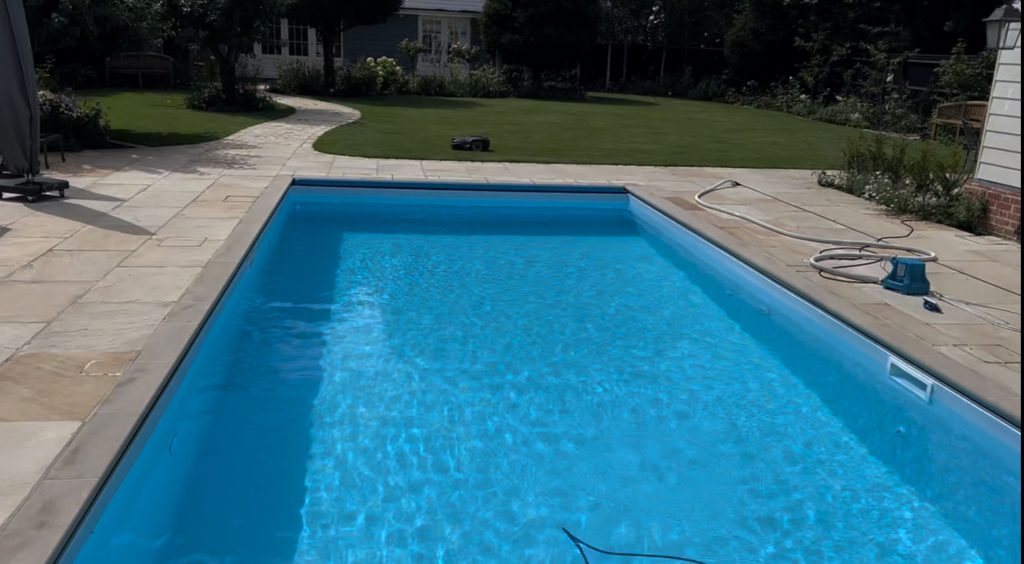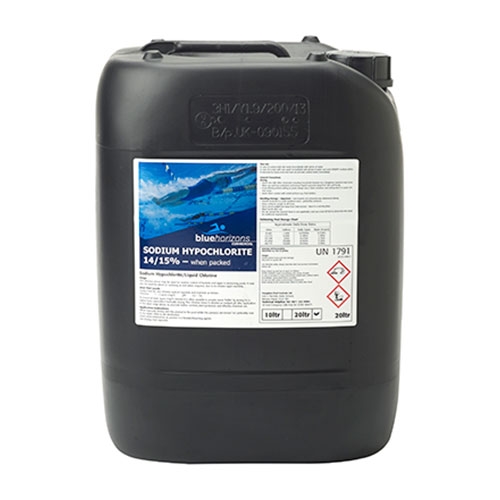Sodium Hypochlorite is a chemical often used in many applications in and around the home. In this review, we put Blue Horizons sodium hypochlorite acid 10% solution product to the test in a swimming pool environment and see how well it performs.
I have been using Blue Horizons Sodium Hypochlorite 14-15% for disinfecting and sanitising a swimming pool over the past few months. This review is part of an ongoing evaluation of its performance and effectiveness.
Ordering, Delivery and Initial Impressions
The product arrived by delivery van from Alliance Disposables in secure black packaging. The strength of the hard plastic seems to do a solid job of preventing any leaks or damage.
The robust container has clearly been designed for easy storage and handling. It’s pretty heavy, though!
Application and Usage
Following the manufacturer’s instructions, normally you might use a specific dosage of the sodium hypochlorite to maintain the pool’s chlorine levels. Such an application process is very straightforward, and the solution mixes well with the pool water.
However, in the setup that I’m using there is an auto-dosing machine which takes care of the levels. This is highly recommended if you want less hassle and more time to do other things than getting close to dangerous chemicals.

Performance Evaluation
Since starting with Blue Horizons Sodium Hypochlorite, I’ve observed a high level of quality in water clarity and algae control. The chlorine levels remain stable, ensuring a clean and safe swimming environment.
This sodium hypochlorite performs exceptionally well although I’ve yet to compare it with competitor products.
Longevity and Value for Money
How long does it last? A lot of this will depend on your swimming pool usage. One 22.5Ltr container is supposed to last approximately three months, making it a cost-effective solution for pool sanitisation.
However, it’s likely to get used up much quicker if you have an outdoor pool that is exposed to the sun for lengthy periods of time. Having a pool cover will help to reduce the usage for sure in this case.
The competitive pricing and high quality make it a good choice for your valuable investment of a swimming pool. To fully evaluate the long-term benefits and consistency of this product, I plan to continue purchasing it.
Safety and Precautions
Handling sodium hypochlorite requires careful attention to safety. Like I do, always wear protective gloves and goggles and ensure the area is well ventilated. The product’s clear instructions help maintain safe usage practices.
Customer Support and Future Purchases
My interactions with the supplier’s customer support have been positive. They provided prompt and helpful responses to my queries. Given the product’s performance, I intend to purchase it again and would recommend it to other pool owners.
To thoroughly evaluate its long-term effectiveness, continued use over several seasons is essential and that’s what we’ll be doing for this ongoing review.
Overall, I am highly satisfied with Blue Horizons Sodium Hypochlorite 14-15%. It has proven to be an effective and reliable solution for maintaining my pool’s chlorine levels and overall water quality. I look forward to continuing its use and updating my review with future observations.
If you want to know more about the details of how the product works, here’s a primer:
How Sodium Hypochlorite Works in a Pool Environment
Sodium hypochlorite functions as a disinfectant and sanitiser in a swimming pool:
Chemical Composition and Release of Chlorine
1. Sodium Hypochlorite (NaOCl):
- Sodium hypochlorite is a chemical compound with the formula NaOCl.
- It is commonly available as a liquid solution containing 14-15% NaOCl for swimming pool use.
2. Dissociation in Water:
When sodium hypochlorite is added to pool water, it dissociates into sodium ions (Na⁺) and hypochlorite ions (OCl⁻):

Disinfection Process
3. Formation of Hypochlorous Acid (HOCl):
- The hypochlorite ions (OCl⁻) react with water to form hypochlorous acid (HOCl), which is the primary disinfectant:

- The formation of hypochlorous acid is pH-dependent, and it is most effective at a pH level between 7.2 and 7.6.
4. Oxidation and Killing Pathogens:
- Hypochlorous acid is a strong oxidising agent that destroys bacteria, viruses, algae, and other microorganisms by breaking down their cell walls and disrupting their metabolic functions.
- This oxidation process sanitises the pool water, making it safe for swimmers.
Maintaining Chlorine Levels
5. Free Chlorine:
- Free chlorine refers to the amount of chlorine available to disinfect the pool. It includes both hypochlorous acid (HOCl) and hypochlorite ions (OCl⁻).
- The ideal free chlorine level in a swimming pool is typically between 1 and 3 parts per million (ppm).
6. Combined Chlorine:
- Combined chlorine forms when free chlorine reacts with organic contaminants, creating chloramines. Chloramines are less effective at sanitising and can cause eye and skin irritation, as well as unpleasant odours.
- Regular shocking (adding a higher dose of chlorine) helps break down chloramines and restore free chlorine levels.
Factors Affecting Effectiveness
7. pH Levels:
- The effectiveness of sodium hypochlorite is influenced by the pool’s pH level. At higher pH levels, a larger proportion of hypochlorite ions (OCl⁻) forms, which are less effective than hypochlorous acid (HOCl).
- Maintaining the pool’s pH between 7.2 and 7.6 ensures optimal effectiveness of the chlorine.
8. Sunlight and Stabiliser:
- Ultraviolet (UV) rays from sunlight degrade chlorine, reducing its effectiveness. Using a stabiliser such as cyanuric acid helps protect chlorine from UV degradation.
- The ideal cyanuric acid level is between 30 and 50 ppm.
Practical Use and Safety
9. Application:
- Sodium hypochlorite should be added to the pool according to the manufacturer’s instructions and based on the pool’s volume.
- It is usually added in front of a return jet to ensure even distribution.
10. Safety Precautions:
- Handle sodium hypochlorite with care, using protective gloves and goggles.
- Store it in a cool, dark place to maintain its potency.
Sodium hypochlorite functions as an effective pool disinfectant by releasing chlorine in the form of hypochlorous acid, which oxidises and destroys harmful microorganisms.
Its effectiveness is maximised by maintaining proper pH levels, using a stabiliser, and following safe handling practices. Regular monitoring and adjustment of chlorine levels ensure a clean, safe, and pleasant swimming environment.
